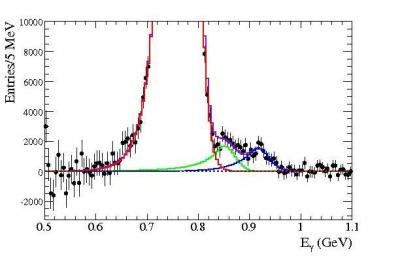After taking data for nine years at an energy corresponding to the mass of the Y(4S) meson as part of a study of B (beauty) mesons and CP symmetry violation during their decay, the BaBar experiment located on the Stanford Linear Accelerator (SLAC) PEP-II storage ring in California collected its last data in the first quarter of 2008 at slightly lower energies, corresponding to the mass of the Y(3S) and Y(2S) mesons. A grand finale!
The two quarks constituting the object have the same mass, and the structure of the excited states spectrum is therefore similar to that of positronium (a bound state containing an electron and a positron) and charmonium (a state formed from a charm quark and an anti-charm quark). The two quarks are bound together by the strong interaction, but the quantum chromodynamics (QCD) describing the interaction does not enable an easy solution of the bound states. The interpretation of the bottomonium spectrum therefore requires the use of theoretical models more or less directly inspired by QCD. These predict a very small difference in mass between the Y(1S) and the ηb, varying between 35 and around 100 MeV/c2. This effect is due to their spin and is called ‘hyperfine separation’. In the same way, the theoretical predictions of the probability of a disintegration of Y(3S) into ηb and a photon are not very accurate and vary between 10-4 and 10-3. It was therefore extremely important to discover this missing piece in the hadron puzzle, and to measure its characteristics accurately.

Photon energy spectrum after subtracting the background noise continuum. The points represent the data, while the red curve models the contribution of the disintegrations of the χbJ(2P) mesons, the green curve the Y(1S) ISR, and the blue curve the ηb meson signal.
It was expected that the ηb meson would disintegrate in a large number of different modes, each with a very low disintegration probability together with high background noise. The search for ηb has therefore been carried out in an inclusive manner, ‘reconstructing’ only the photon emitted during the disintegration of Y(3S) to ηb. The energy of this ‘recoil’ photon would be 911 MeV for an ηb with a mass of 9.4 GeV/c2. The analysis was made difficult by the presence of high levels of background noise producing a continuum of photons emitted by other processes occurring during the e+ e- collisions and exhibiting a monotonic energy spectrum. In addition, there were two sources of background noise with energy peaks close to the target signal. Firstly, the many disintegrations of χbJ(2P) into Y(1S) and a photon produce a peak in the photon energy spectrum close to 770 MeV. Secondly, the direct production of Y(1S) mesons in the e+ e- collision, with initial state radiation (ISR), produces another peak at 860 MeV. This peak is less intense than the first, but it is closer to the target signal. These contributions are visible in the photon energy spectrum shown in Figure 2. Studies on control samples, especially those carried out with a beam energy well away from any known resonances, have provided an accurate knowledge of the shape of the peak due to ISR. The uncertainty generated in the values of the ηb parameters is therefore very small. In the words of Philippe Grenier who led the analysis: “An understanding of these two processes was absolutely crucial, especially with regard to the ISR peak which partially overlapped the signal”.
The ηb meson was therefore observed at a mass of 9388.9 +3.1-2.3 ± 2.7 MeV/c2, with a statistical significance of around 10 standard deviations. The probability of disintegration of Y(3S) into an ηb and a photon was measured as: (4.8 ± 0.5 ± 1.2) 10-4.
The observation of ηb is an important step in the exploration of the bottomonium sector of the hadrons, and the accurate measurement of its characteristics is a determining factor in the testing and determination of the parameters of the theoretical models describing the strong interaction.
BaBar is an international collaboration with contributions from five French laboratories, four from the IN2P3 (LAL Orsay, LAPP Annecy, LPNHE Paris 6-7, and LLR Ecole Polytechnique), and the CEA Irfu.
For more information, contact:
Irfu/SPP
• The ultimate constituents of matter › Particle physics at colliders
• Institute of Research into the Fundamental Laws of the Universe • The Particle Physics Division
• BABAR
